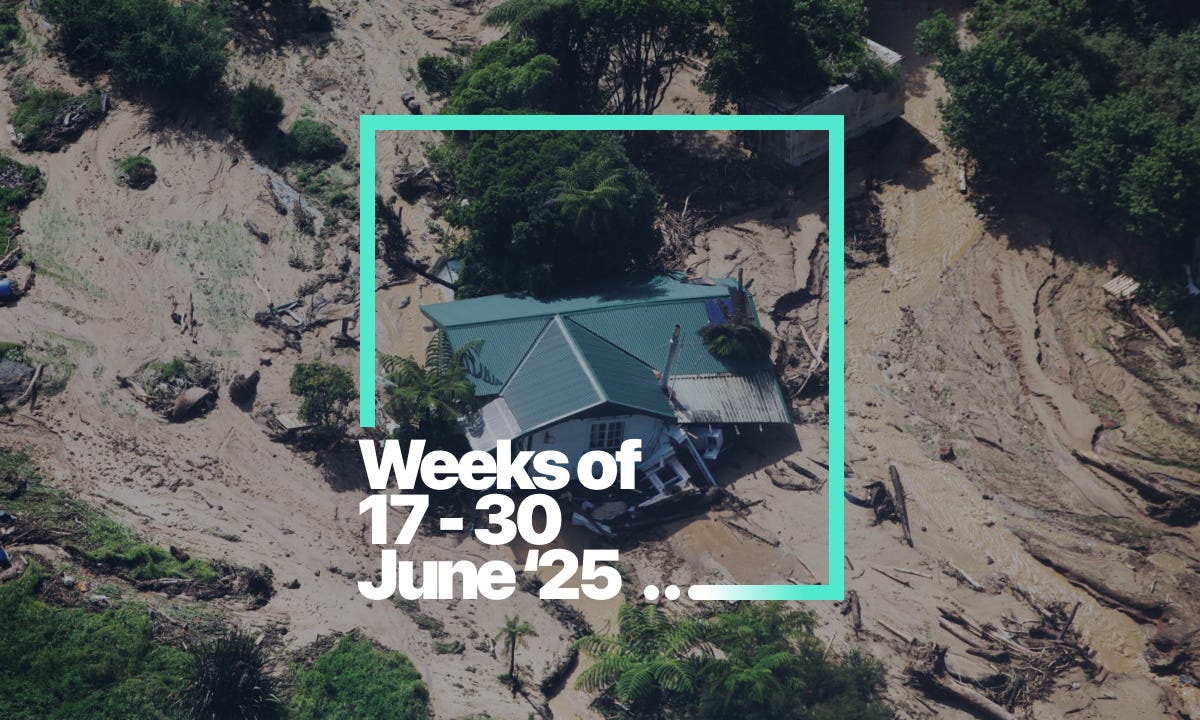Hello 👋 get a brew on because these are the top 3 emerging risks between June 16th, and June 30th, 2025…
Review our report’s terminology here ↗
Our main risk this fortnight is…
1. Environmental & Economic: The impact on global insurance through climate change.
Weekend flooding exposes systemic crisis: The June 28-29 Nelson-Tasman flooding killed one person and generated 373+ insurance claims worth millions, but it's just the latest event in New Zealand's collapsing insurance market.
Exponential loss escalation: Insurance claims exploded from $17 million annually in the 1990s to $3.5 billion in 2023 - a 402% spike from 2022 alone. Cyclone Gabrielle generated $14.5 billion in total economic damage, making it the Southern Hemisphere's costliest tropical cyclone.
Insurers abandoning entire communities: IAG New Zealand stopped issuing new policies on 20,000 flood-prone homes (1% of all residential properties), while business interruption insurance becomes unavailable or prohibitively expensive.
Global pattern emerging: Similar insurer withdrawals are happening worldwide - Florida saw 15 insurers implement moratoriums, California's State Farm stopped new applications entirely, and global insured losses hit $140 billion in 2024.
Adaptation strategies essential: Businesses must diversify beyond traditional insurance through parametric coverage, captive insurance structures, operational flexibility, and comprehensive continuity planning to survive the new reality.
Sources
Australian, New Zealand property markets face creeping climate risks | Reuters | July 1, 2024
Tasman, Nelson to prepare for more heavy rain following flooding | RNZ | June 30, 2025
2023 climate disaster payouts top $2 billion | Insurance Council of New Zealand | February 28, 2024
You should be concerned if…
You own or operate commercial property in flood-prone areas - Business interruption insurance is becoming either unavailable or prohibitively expensive. Cyclone Gabrielle alone generated over $350 million in business interruption claims.
You depend on supply chains through climate-vulnerable regions - University of Maryland research found that late shipments rose 26-32% in European regions hit by flooding. One day of business interruption costs firms an average of 0.5% of annual revenue.
You're in agriculture or food production - Peter Lines' tragic death symbolises how agricultural communities bear the brunt of escalating climate risks. Hop farms in the Motueka Valley face severe crop and infrastructure damage from repeated flooding.
You operate in tourism or hospitality - These industries face dual exposure through both property damage and customer access disruption when critical infrastructure fails during climate events.
You rely on traditional insurance models - With 40% of businesses closing permanently after catastrophic flooding and 90% of smaller companies failing within a year unless they resume operations within five days, traditional insurance coverage simply isn't enough any more.
You're located in high-risk areas globally - New Zealand's experience is spreading worldwide, with insurers withdrawing from Florida, California, and other climate-vulnerable regions, leaving businesses without affordable coverage options.
These items are generic assumptions. We recommend considering your own unique risk landscape against your critical dependencies. If you don’t know what they are, get in touch.
Preventative actions
Diversify your insurance approach
Don't rely solely on traditional coverage. Parametric insurance is projected to reach $34.4 billion by 2033. Companies like FloodFlash provide payouts within 48-72 hours when water depth triggers are reached, with 97% acceptance rates regardless of flood history.
Implement property-level adaptations
Elevate critical infrastructure, use flood-resistant design principles, and install certified temporary flood barriers. The investment is substantial, but research shows $10 million in prevention can prevent $100 million in damages.
Build operational flexibility
Create redundant power systems, protect data with off-site backup, and establish flexible working arrangements. The key is enabling business continuity from alternate locations when your primary site becomes inaccessible.
Map your supply chain vulnerabilities
Understand risks beyond immediate suppliers through multi-tier mapping. Geographic diversification reduces dependence on single-region sourcing, while real-time monitoring enables rapid response to disruptions.
Consider captive insurance structures
90% of Fortune 500 companies now use captive insurance subsidiaries for customised risk management. These provide cost stabilisation and coverage for risks unavailable in traditional markets.
Invest in monitoring technology
IoT sensor networks provide real-time water level monitoring, while AI-powered platforms combine satellite observation with ground data for comprehensive flood analysis and predictive analytics.
Plan for sustained cost increases
Premium escalation isn't temporary. With 18% annual increase caps on flood insurance, high-risk properties face multi-year cost escalation requiring long-term financial planning.
2. Technological: Lessons from Air India Flight 171 & aviation supply chain.
Catastrophic crash exposes system-wide failures: Air India Flight 171 crashed 30 seconds after take-off on June 12, 2025, killing 241 people in the 787 Dreamliner's first fatal accident, revealing dangerous vulnerabilities in global aviation systems.
India's aviation sector under siege: Geopolitical conflicts forced Air India to suspend ALL flights to Middle East, Europe, and North America, while Pakistan's airspace closure costs the industry $800 million annually and forces costly detours for 800+ weekly flights.
Global supply chain crisis accelerating: Factory fires caused 1,250+ incidents in 2023, component lead times doubled from 18 to 30 weeks, and 160 aircraft (25% of India's fleet) remain grounded due to parts shortages and maintenance delays.
Insurance costs skyrocketing globally: The crash triggers 10-30% premium increases across the entire aviation sector, with the $475 million insurance claim affecting every airline worldwide, not just Air India.
Business adaptation essential: Companies must diversify transportation methods, build 60-90 day inventory buffers, map supply chain vulnerabilities, and implement "China+1" supplier strategies to survive aviation network failures and reduce disruption risk by 25-30%.
Sources
Air India crash is the latest test for new Boeing leadership | Reuters | June 12, 2025
Air India crash: What to know about the first fatal Boeing Dreamliner tragedy | CNBC | June 12, 2025
You should be concerned if…
You're in the aviation supply chain - If you manufacture components, provide maintenance services, or work in aerospace, you're facing direct impact. Lead times have doubled, insurance costs are rising 30%, and regulatory scrutiny is intensifying globally.
You rely on just-in-time logistics - Manufacturing companies using air freight for time-sensitive components face massive disruption risks. Alternative routing adds 2-6 hours to journey times and significant costs.
You operate across ASEAN/Pacific routes - Regional hub disruptions cascade across multiple countries. Singapore, Bangkok, and Kuala Lumpur hub problems affect entire regional connectivity. Countries with 12% GDP dependence on tourism face severe economic impacts.
You depend on business travel - With permanent 15-25% decline in business travel, companies relying on face-to-face client relationships must adapt operations fundamentally.
You're in industries with critical air cargo needs - Perishable goods, high-tech manufacturing, medical supplies, and e-commerce fulfilment face supply chain vulnerabilities when aviation networks fail.
These items are generic assumptions. We recommend considering your own unique risk landscape against your critical dependencies. If you don’t know what they are, get in touch.
Preventative actions
Diversify your transportation methods
Don't rely solely on air freight. Develop multimodal logistics using sea, rail, and road transport. Companies with diversified transportation reduce supply chain disruption risk by 25-30%.
Build inventory buffers
Move away from just-in-time inventory for critical components. Maintain 60-90 day buffers for essential supplies. This costs 10-15% more but prevents catastrophic disruptions.
Map your supply chain vulnerabilities
Identify Tier-3 and Tier-4 suppliers who depend on aviation. Many companies don't know their supply chains beyond direct suppliers, creating blind spots during aviation crises.
Develop alternative supplier networks
Implement "China+1" strategies across different geographic regions. Consider suppliers in Mexico, India, Vietnam, and ASEAN countries to reduce single-point-of-failure risks.
Invest in supply chain visibility technology
AI-powered monitoring systems provide early warning of disruptions. Companies using predictive analytics reduce crisis response time by 40-50%.
Review your insurance coverage
Assess political risk insurance, trade credit insurance, and supply chain interruption coverage. Aviation insurance costs are rising, but comprehensive coverage prevents larger losses.
Establish crisis communication protocols
Create dedicated teams for aviation disruption response with clear escalation procedures and stakeholder communication plans.
Want to discuss how these risks might effect your business?
Book 30 minutes with us, free ↗
Need support?
At Fixinc, we are passionate about helping people get through disasters. That’s why our team of Advisors bring you this resource free of charge. If you need help understanding these threats and building a plan against them, the same Advisors are here to help over a 30-minute online call. Once complete, if you like what was provided, you can choose to provide a donation or subscribe to Unreasonable Ventures to support this channel.

















